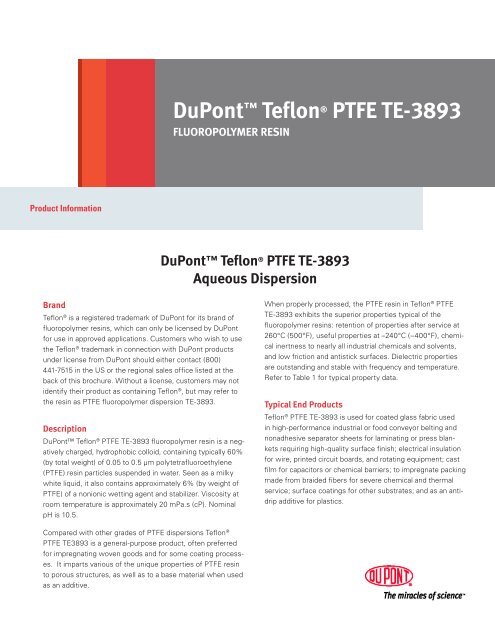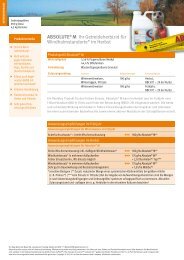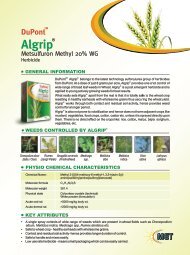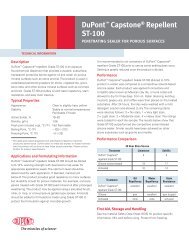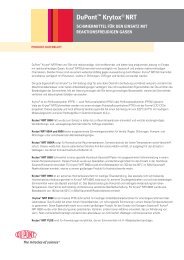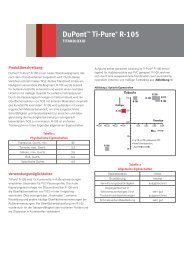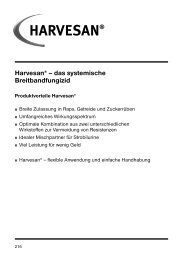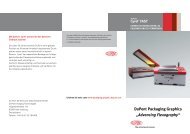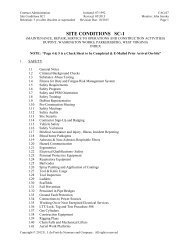DuPont™ Teflon® PTFE TE-3893 Aqueous Dispersion
DuPont™ Teflon® PTFE TE-3893 Aqueous Dispersion
DuPont™ Teflon® PTFE TE-3893 Aqueous Dispersion
Create successful ePaper yourself
Turn your PDF publications into a flip-book with our unique Google optimized e-Paper software.
FDA ComplianceProperly processed products (sintered at high temperaturescommon to the industry) made from Teflon ® <strong>PTFE</strong> <strong>TE</strong>-<strong>3893</strong>resin can qualify for use in contact with food in compliancewith FDA Regulation 21 CFR 177.1550 and the German BGA.Products made from unsintered dispersion do not comply.Processing<strong>PTFE</strong> resin cannot be processed by solvent or melt techniques.A dispersion of <strong>PTFE</strong> particles provides an alternatemethod for making coated or impregnated products.Conventional dip or flow techniques can be used for coatingor impregnating other products with Teflon ® <strong>PTFE</strong> <strong>TE</strong>-<strong>3893</strong>.The resin particles can be consolidated by heat into a coherentmatrix or coating or left as particles to influence theproperties of a finished product.A continuous <strong>PTFE</strong> resin coating on woven fabrics can bemade by dip coating. Successive passes must be used tobuild up thickness slowly and without cracks. Teflon ® <strong>PTFE</strong><strong>TE</strong>-<strong>3893</strong> fluoropolymer provides good rewetting on eachpass and void-free buildup suitable for more demanding electricaland chemical service applications. Each coating layeris usually dried to remove water (typically at 120°C [250°F]),baked to remove the wetting agent (typically at 270°C[518°F]), sometimes calendered, and finally heated above thecrystalline melting point of the resin particles (approximately337°C [639°F]). Glass, <strong>PTFE</strong>, Nomex ® aramid fiber, Kevlar ®aramid fiber, or other high-temperature resistant fibers mustbe used.Products utilizing entrained <strong>PTFE</strong> resin particles only for theirlubricating or hydrophobic properties are dried and baked,but not heated above the crystalline melting point of theparticles. For example, rope-like products, such as shaftpackings, can be made from braided yarn in a variety of crosssections. The dispersion wets internal surfaces and promotespenetration of the extremely small particles. The unmeltedparticles are sheared and retained as an impregnant, evenwhen compressed in service and exposed to steam orchemicals. Unmelted particles also can improve flexibilityand flex life. High-temperature resistant fibers are notnecessarily required in these applications.Other solid or liquid ingredients can be added to Teflon ® <strong>PTFE</strong><strong>TE</strong>-<strong>3893</strong> to provide specific processing or finished productbehavior.Safety PrecautionsWARNING!VAPORS CAN BE LIBERA<strong>TE</strong>D THAT MAY BE HAZARD-OUS IF INHALED.Before using Teflon ® <strong>PTFE</strong> <strong>TE</strong>-<strong>3893</strong>, read the Material SafetyData Sheet and the detailed information in the “Guide to theSafe Handling of Fluoropolymer Resins,” latest edition, publishedby the Fluoropolymers Division of The Society of thePlastics Industry or the “Safe handling of Fluoropolymer dispersions”published by the APME —available from DuPont.Open and use containers only in well-ventilated areas usinglocal exhaust ventilation (LEV). Vapors and fumes liberatedduring hot processing, or from smoking tobacco or cigarettescontaminated with Teflon ® <strong>PTFE</strong> <strong>TE</strong>-<strong>3893</strong> fluoropolymerresin, may cause flu-like symptoms (chills, fever, sore throat)that may not occur until several hours after exposure andpass within about 24 hours. Vapors and fumes liberatedduring hot processing should be exhausted completely fromthe work area; contamination of tobacco with polymersshould be avoided.Mixtures with some finely divided metals, such as magnesiumor aluminum, can be flammable or explosive undersome conditions.Teflon ® <strong>PTFE</strong> <strong>TE</strong>-<strong>3893</strong> contains additives in the aqueousphase that are irritants. Avoid contact with skin and eyes.In case of skin contact, flush with water immediately. Incase of eye contact, flush with water immediately and getmedical help.Storage and HandlingThe dispersion particles in Teflon ® <strong>PTFE</strong> <strong>TE</strong>-<strong>3893</strong> will settleon prolonged standing or on heating above 65°C (150°F).They usually can be redispersed by mild agitation. Drumsmay be rolled or the product stirred gently just prior to use.The dispersion must be protected from freezing, which willcause irreversible settling.Ammonium hydroxide is used by DuPont to set pH to 10at the time of shipment. High ambient temperatures candeplete the ammonia level and reduce the pH. Declining pHeventually favors bacterial growth, which causes odor andscum. The pH should be measured and maintained between9.5 and 10.5.Both very high and very low temperatures may be detrimental.<strong>Dispersion</strong>s must not be allowed to freeze. The optimumstorage temperature range is 7–24°C (45–75°F), withtemperatures low in the range preferred. Storage at 7–32°C(45–90°F) is acceptable within nominal shelf life for standarddispersions. If dispersions are to be stored for extendedperiods beyond their nominal shelf life, low-temperature storageis especially desirable because the particles are harderat lower temperatures and, therefore, are less likely to sticktogether as they settle.
High-speed stirring, pumping, or any other violent agitationmust be avoided to minimize sheared particles or coagulationand to minimize foaming. Ideally, the dispersion should beconveyed by gravity from storage to processing stations.Storage and handling areas should be clean. Keep dispersiondrums closed and clean to avoid both contamination andcoagulation by drying at the liquid surface. High processingtemperatures will cause even very small foreign particlesto become visible or to make defects in finished products.Good housekeeping and careful handling are -essential.PackagingTeflon ® <strong>PTFE</strong> <strong>TE</strong>-<strong>3893</strong> is packaged in 19-, 30- and 114-L(5-, 8- and 30-gal) non-returnable drums and 1000-L(275-gal) recyclable containers. Contact the local DuPontsales office for package sizes available in your specificgeographic area.Freight ClassificationTeflon ® <strong>PTFE</strong> <strong>TE</strong>-<strong>3893</strong>, when shipped by rail or express,is classified “Plastics, Synthetic, Liquid, NOIBN.” Resinshipped by truck is classified “Plastics, Materials, Liquid,NOI.”Table 1Typical Property Data for DuPont Teflon ® <strong>PTFE</strong> Fluoropolymer Resin <strong>Dispersion</strong> Grade <strong>TE</strong>-<strong>3893</strong>Typical Property Data for Teflon ® <strong>TE</strong><strong>3893</strong>Property Test method (1) Unit Typical valueGeneralSolids content (% <strong>PTFE</strong> by weight) ISO 12086 D 4441 % 60Density of dispersion (at 60% solids) ISO 8962 D 4441 g/cm3 1.50Resin dry weight (at 60% solids)/liter dispersion DuPont g 900ColorWhite<strong>Dispersion</strong> particle size, average diameter ISO 13321 DuPont µm 0.210pH of dispersion ISO 976 E 70 10.0Brookfield viscosity (at 25°C) ISO 2555 D 2196 mPa·s (cP) 25 (25)Standard specific gravity of sintered resin ISO 12086 2.220Mechanical (2)Tensile strength ISO 12086 D 882 MPa (psi) 24 (3500)Ultimate elongation ISO 12086 D 882 % 400Electrical (2)Relative permittivity (100 Hz to 60 MHz) IEC 250 D 150 2.1Dissipation factor, tg δ (1 kHz) IEC 250 D 150 120Volume resistivity IEC 93 D 257 W·m 1013Thermal (2)Initial Melt, Peak Temperature D4895 °C 337Second Melt, Peak Temperature D4895 °C 327Brittleness temperature D 746 °C < –75Continuous service temperature (max) °C 260Other (2)Water absorption D 570 % < 0.01Weather and chemical resistanceExcellentNote: Teflon ® <strong>TE</strong>-<strong>3893</strong> meets the requirements of ASTM D 4441-04, type II, grade 6, class B.Typical properties are not suitable for specification purposes.Decimals are indicated by a period (.)(1)ASTM unless otherwise specified.(2)These results are based on tests made on thin cast films.
For more information call (302) 479-7731www.teflon.comDuPont FluoroproductsP.O. Box 80713Wilmington, DE 19880-0713EuropeDuPont de Nemours Int’l SADuPont Fluoroproducts2, chemin du PavillonP.O. Box 50CH-1218 Le Grand-SaconnexGeneva, Switzerland+44 22 717 5111Fax: +41 22 717 5411JapanDuPont Mitsui FluorochemicalsCo., Ltd.Chiyoda Honsha Building5–18, Sarugaku-cho 1-chomeChiyoda-ku, Tokyo 101 Japan81-3-5281-5872Asia PacificDuPont China, Limited26/F., Tower 6, The Gateway9 Canton Road, TsimshatsuiKowloon, Hong Kong(852) 27341948Tim-S.T.Leung@hkg.dupont.comCanadaDuPont Canada, Inc.DuPont FluoroproductsP.O. Box 2200, Streetsville7070 Mississauga RoadMississauga, Ontario, CanadaL5M 2H3(302) 479-7731South AmericaDuPont do Brasil S/AFluoropolymersAlameda Itapecuru, 50606454-080 - AlphavilleP.O. Box 263Barueri, Sao Paulo, Brazil0800-171715Produtos.Brazil@bra.dupont.comCopyright © 2005 DuPont or its affiliates. All rights reserved. The DuPont Oval Logo, DuPont , The miracles of science ,Nomex ® , Kevlar ® , and Teflon ® , are registered trademarks or trademarks of E. I. du Pont de Nemours and Company or its affiliates.NO PART OF THIS MA<strong>TE</strong>RIAL MAY BE REPRODUCED, STORED IN A RETRIEVAL SYS<strong>TE</strong>M OR TRANSMIT<strong>TE</strong>D IN ANY FORM ORBY ANY MEANS ELECTRONIC, MECHANICAL, PHOTOCOPYING, RECORDING OR OTHERWISE WITHOUT THE PRIOR WRIT<strong>TE</strong>NPERMISSION OF DUPONT.The information set forth herein is furnished free of charge and is based on technical data that DuPont believes to be reliable. It isintended for use by persons having technical skill, at their own discretion and risk. The handling precaution information containedherein is given with the understanding that those using it will satisfy themselves that their particular conditions of use present nohealth or safety hazards. Because conditions of product use are outside our control, we make no warranties, express or implied,and assume no liability in connection with any use of this information. As with any material, evaluation of any compound underend-use conditions prior to specification is essential. Nothing herein is to be taken as a license to operate under or a recommendationto infringe any patents.CAUTION: Do not use in medical applications involving permanent implantation in the human body or contact with internal bodyfluids or tissues. For other medical applications, see “DuPont Medical Caution Statement,” H-50102.(4/06) RWJ368 Printed in U.S.A.Reorder No.: K-15314


